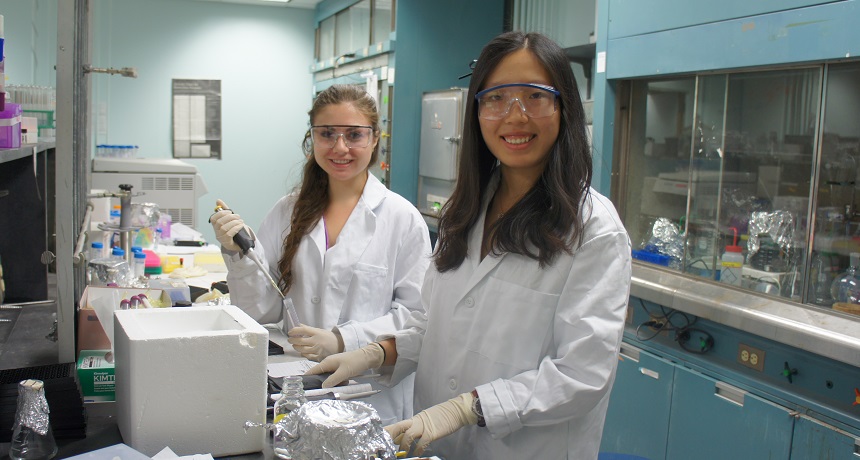Teen’s lab experience benefits her mentor, too
High Schoolers are expected to learn a lot from scientists. But scientists can glean plenty in return

Courtney Schwartz (left) got to work with Yuanyuan Si (right) over the summer. The teen learned a lot about lab work, while her mentor learned plenty about teaching.
P. Tonge
Some lucky high school students find a summer job doing research at a university. It might seem these teens would be the big winners in such a situation. And Courtney Schwartz, 17, would agree. Her lab experience taught her about chemistry, about failure and about patience. But her mentor says that she benefited as well, and probably learned as much as her student.
“We all improve through teaching,” says Yuanyuan Si, a graduate student at Stony Brook University in New York. “Sometimes, Courtney asks me questions, and in trying to come up with the answers, I end up understanding my own work better,” she says.
Going into her second year of grad school, Yuanyuan had her doubts about whether she knew enough to teach a student. As it turns out, she did. Yuanyuan got to work with Courtney, and in this teen discovered a student who was already dedicated to research.
“I was always very interested in science,” recalls Courtney, now a rising senior at The Wheatley School in Old Westbury, N.Y. “Around seventh grade I began taking biology and something about it sparked my curiosity.” Three years ago she got her first lab job. She had secured a spot to do research at nearby Cold Spring Harbor Laboratory. There, she worked with bacteria and their DNA — the molecules inside cells that serve as a manual to keep the cell running and reproducing.
The next year, she applied to do research for the summer with the GARCIA program in materials science and engineering at Stony Brook University. It’s a program for high school teachers and students to do research on polymers — large molecules made of repeating units, such as plastics, proteins and gels. Courtney cultured cells on a special gel that stands in for human skin. The teen tried to see if a thinner gel — suggestive of a thinner skin — left cells more vulnerable to infection.
Now she’s back at Stony Brook University as part of the Simons Summer Research Program. Here, she works with Yuanyuan on an enzyme called DNA ligase. Enzymes are molecules that speed up reactions. In this case, DNA ligase helps bring two strands of DNA together. In normal human cells, DNA ligase is a great thing. But in harmful bacteria, DNA ligase is part of what makes bacteria replicate — and may therefore make us sick. Courtney and Yuanyuan are trying to develop a drug to inhibit the DNA ligase in these germs. If the drug can stop the bacteria from replicating, it might save many lives.
Spending her summer making new molecules and testing them, Courtney learned a lot about failure. “A lot of times you’ll try an experiment and it won’t work the first time, or the first three times,” she says. “You have to keep a good mindset. You can’t give up.”
For her part, Yuanyuan learned a lot about how to encourage the teen. “Sometimes even I don’t know if an experiment is going to work,” Yuanyuan says. “We need to try something several times, and I need to keep up my confidence that we can make it work. I have to give confidence to Courtney as well as to myself.”
One added benefit: Explaining her project to a high school student has helped Yuanyuan explain it to other people, too. And working with Courtney helped make the grad student’s summer fun. “She is 17 and I’m 23,” Yuanyuan says. “So we aren’t very different. We can talk about lots of things besides research. We have a great relationship.”
Follow Eureka! Lab on Twitter
Power Words
bacterium (plural bacteria) A single-celled organism forming one of the three domains of life. These dwell nearly everywhere on Earth, from the bottom of the sea to inside animals.
DNA (short for deoxyribonucleic acid) A long, spiral-shaped molecule inside most living cells that carries genetic instructions. In all living things, from plants and animals to microbes, these instructions tell cells which molecules to make.
DNA ligase An enzyme that helps “glue” strands of DNA together. DNA ligase is important for pairing up newly made DNA after a cell divides.
enzymes Molecules made by living things to speed up chemical reactions.
polymer Substances whose molecules are made of long chains of repeating groups of atoms. Manufactured polymers include nylon, polyvinyl chloride (better known as PVC) and many types of plastics. Natural polymers include rubber, silk and cellulose (found in plants and used to make paper, for example).